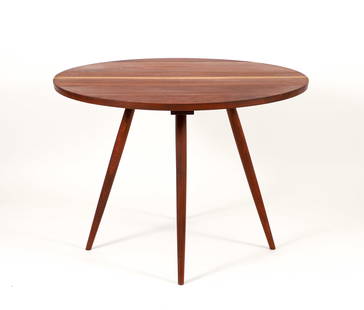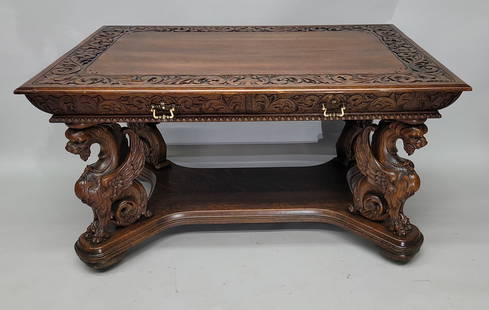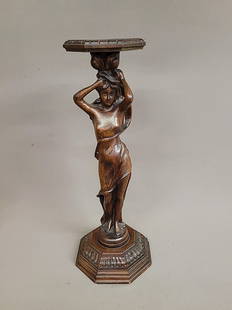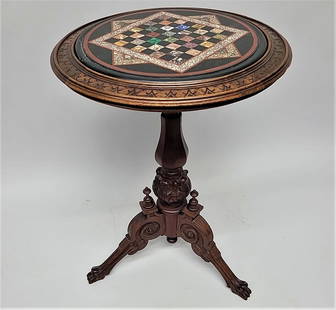
George Nakashima, Dresser
Similar Sale History
View More Items in Dining TablesRelated Dining Tables
More Items in Dining Tables
View MoreRecommended Tables
View More


Item Details
Description
George Nakashima
Dresser
Executed 1963
American black walnut
Studio
Marked "Bennett #2025"
31.75" x 60" x 19.75"
Provenance: Property from the Edmund J. Bennett Collection (acquired directly from the Nakashima studio)
In 1962, Edmund J. Bennett, self-taught residential builder and community planner, opened the Carderock Springs subdivision in Bethesda, Maryland, a housing development that promised community and modern living. Ahead of its time, the Carderock Springs subdivision featured homes with 4- and 5-bedroom floor plans, which were "modeled to cause as little alteration to the natural landscape as possible." The homes offered privacy and natural solitude, yet families had the opportunity to build a sense of community at the centrally located clubhouse where they could play tennis, go swimming, or go sledding.
One of the first communities to utilize pre-fabricated sections, underground utilities, and cul-de-sacs, Carderock Springs homes were angled towards the forest, allowing expansive views through the wide-open floor-to-ceiling windows. Some of the other "atrium houses" were built to include a vibrant courtyard at the center of the living space. While the houses looked small and cozy from the outside, the high ceilings and open floor plans provided airiness in harmony with the natural surroundings. Nestled between Congressional Country Club and Cabin John Regional Park, the subdivision offered woods, hills, and solitude only 20 minutes from downtown Washington D.C.
In addition to his modern housing designs and the scenic location, Bennett was a savvy marketer. In November 1963, to publicize a newly developed section in the subdivision, Bennett, with the help of architect-designer Doris Harris, commissioned George Nakashima to completely furnish the Valleyview model home to attract the attention of contemporary buyers. Bennett's marketing strategy paid off. On November 16, 1963, The Washington Post published an article about George Nakashima, his designs, and the Carderock Springs subdivision, bringing over 1,000 people to the model home that week alone. Mr. Bennett later stated that he had to call in his entire staff to help manage the crowds who came to see both the furniture and Mr. Nakashima. Due to its proximity to Washington and Nakashima's contemporary designs, the development attracted a diverse group of families from around the world. To this day, the community remains internationally minded, and much of the homes are decorated with art from around the world.
The Nakashima designs created for the model home – over 30 in total – represented some of the furniture designer's most contemporary styles and advanced woodworking techniques. Nakashima was quoted in a local newspaper at the time, stating, "I respect antiques, but I see no reason to copy them. The men who made early American furniture did not make the furniture to be antiques. They made furniture for their time." One of these designs, the Conoid bench (1963), features a long, low slab of American black walnut that doubles as an end table, a practical and attractive innovation. The word Conoid refers to Nakashima's incredible Conoid Studio that he had recently designed and completed in the late 1950s. The model home collection also features one of Nakashima's most innovative designs, the Cross-legged dining table (1963). According to his daughter Mira, the cross-legged base "reflects a lightness and freedom, whimsy and joy, which must have pervaded Nakashima's life at the time." Additional designs from the model home featured the natural characteristics of the American black walnut wood. The Slab II coffee table (1963) presents the walnut slab's rotted out sections, knots, and crotch figures, seamlessly complimenting Bennett and Harris' hardwood floors and forest views.
When Edmund Bennett sold his company in 1973, he brought the entire collection into his home, and in 1989 he built a home in Bethesda designed to accommodate each piece of Nakashima furniture. Bennett admired Nakashima and his designs, and Nakashima listened carefully to his client's requests. In 1978, Nakashima sent Bennett a detailed drawing and letter asking if a piece of English walnut would suffice, and Bennett responded that he would wait to see if Nakashima could find some American black walnut. The resulting Table lamp (executed in 1978) is a rare piece that demonstrates Nakashima's ability to showcase both his craft and the wood's natural beauty. Also in 1978, Bennett commissioned Nakashima for six Conoid chairs – one of his most popular designs – as well as a Frenchman's Cove dining table. Nakashima originally produced the Frenchman's Cove line of furniture for the Jamaican resort of the same name. It became one of Nakashima's most popular designs, and he continued producing the table for many years. In 1984, Bennett asked Nakashima for an extension for the table as well as six more Conoid chairs. The two visionaries developed their styles independently, but their paths crossed at Carderock Springs to result in a conscientious collaboration of the era's most innovative furniture design and architecture that would last a lifetime.
Nakashima, Mira. Nature, Form, & Spirit: The Life and Legacy of George Nakashima. New York: Abrams, 2003.
"George Nakashima, Woodworker." The Washingtonian. Jan. 1967: 25. Print.
Estimate: $7000 - $10000
Dresser
Executed 1963
American black walnut
Studio
Marked "Bennett #2025"
31.75" x 60" x 19.75"
Provenance: Property from the Edmund J. Bennett Collection (acquired directly from the Nakashima studio)
In 1962, Edmund J. Bennett, self-taught residential builder and community planner, opened the Carderock Springs subdivision in Bethesda, Maryland, a housing development that promised community and modern living. Ahead of its time, the Carderock Springs subdivision featured homes with 4- and 5-bedroom floor plans, which were "modeled to cause as little alteration to the natural landscape as possible." The homes offered privacy and natural solitude, yet families had the opportunity to build a sense of community at the centrally located clubhouse where they could play tennis, go swimming, or go sledding.
One of the first communities to utilize pre-fabricated sections, underground utilities, and cul-de-sacs, Carderock Springs homes were angled towards the forest, allowing expansive views through the wide-open floor-to-ceiling windows. Some of the other "atrium houses" were built to include a vibrant courtyard at the center of the living space. While the houses looked small and cozy from the outside, the high ceilings and open floor plans provided airiness in harmony with the natural surroundings. Nestled between Congressional Country Club and Cabin John Regional Park, the subdivision offered woods, hills, and solitude only 20 minutes from downtown Washington D.C.
In addition to his modern housing designs and the scenic location, Bennett was a savvy marketer. In November 1963, to publicize a newly developed section in the subdivision, Bennett, with the help of architect-designer Doris Harris, commissioned George Nakashima to completely furnish the Valleyview model home to attract the attention of contemporary buyers. Bennett's marketing strategy paid off. On November 16, 1963, The Washington Post published an article about George Nakashima, his designs, and the Carderock Springs subdivision, bringing over 1,000 people to the model home that week alone. Mr. Bennett later stated that he had to call in his entire staff to help manage the crowds who came to see both the furniture and Mr. Nakashima. Due to its proximity to Washington and Nakashima's contemporary designs, the development attracted a diverse group of families from around the world. To this day, the community remains internationally minded, and much of the homes are decorated with art from around the world.
The Nakashima designs created for the model home – over 30 in total – represented some of the furniture designer's most contemporary styles and advanced woodworking techniques. Nakashima was quoted in a local newspaper at the time, stating, "I respect antiques, but I see no reason to copy them. The men who made early American furniture did not make the furniture to be antiques. They made furniture for their time." One of these designs, the Conoid bench (1963), features a long, low slab of American black walnut that doubles as an end table, a practical and attractive innovation. The word Conoid refers to Nakashima's incredible Conoid Studio that he had recently designed and completed in the late 1950s. The model home collection also features one of Nakashima's most innovative designs, the Cross-legged dining table (1963). According to his daughter Mira, the cross-legged base "reflects a lightness and freedom, whimsy and joy, which must have pervaded Nakashima's life at the time." Additional designs from the model home featured the natural characteristics of the American black walnut wood. The Slab II coffee table (1963) presents the walnut slab's rotted out sections, knots, and crotch figures, seamlessly complimenting Bennett and Harris' hardwood floors and forest views.
When Edmund Bennett sold his company in 1973, he brought the entire collection into his home, and in 1989 he built a home in Bethesda designed to accommodate each piece of Nakashima furniture. Bennett admired Nakashima and his designs, and Nakashima listened carefully to his client's requests. In 1978, Nakashima sent Bennett a detailed drawing and letter asking if a piece of English walnut would suffice, and Bennett responded that he would wait to see if Nakashima could find some American black walnut. The resulting Table lamp (executed in 1978) is a rare piece that demonstrates Nakashima's ability to showcase both his craft and the wood's natural beauty. Also in 1978, Bennett commissioned Nakashima for six Conoid chairs – one of his most popular designs – as well as a Frenchman's Cove dining table. Nakashima originally produced the Frenchman's Cove line of furniture for the Jamaican resort of the same name. It became one of Nakashima's most popular designs, and he continued producing the table for many years. In 1984, Bennett asked Nakashima for an extension for the table as well as six more Conoid chairs. The two visionaries developed their styles independently, but their paths crossed at Carderock Springs to result in a conscientious collaboration of the era's most innovative furniture design and architecture that would last a lifetime.
Nakashima, Mira. Nature, Form, & Spirit: The Life and Legacy of George Nakashima. New York: Abrams, 2003.
"George Nakashima, Woodworker." The Washingtonian. Jan. 1967: 25. Print.
Estimate: $7000 - $10000
Buyer's Premium
- 28%
George Nakashima, Dresser
Estimate $7,000 - $10,000
3 bidders are watching this item.
Shipping & Pickup Options
Item located in Van Nuys, CA, usSee Policy for Shipping
Payment

Related Searches
TOP









































































